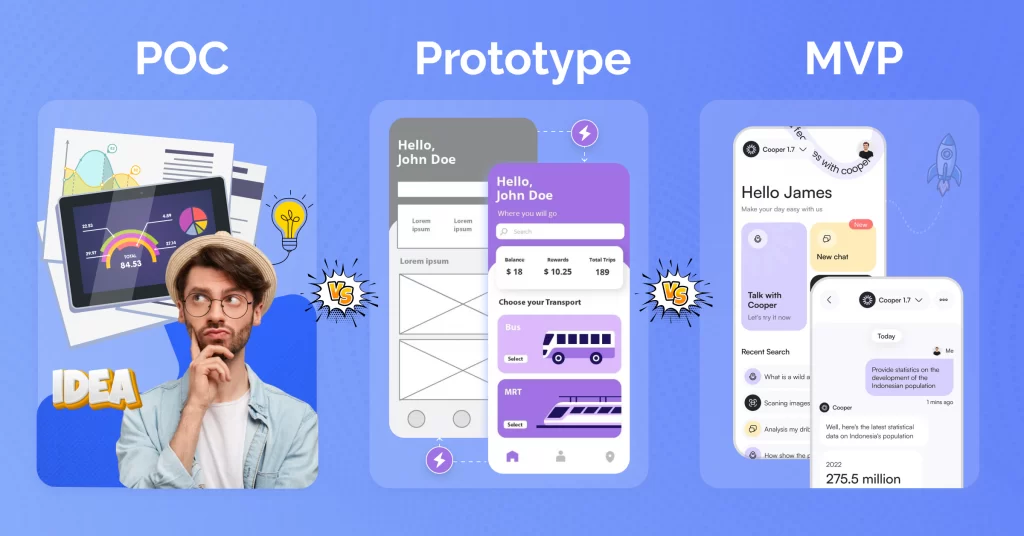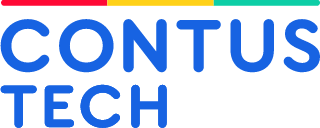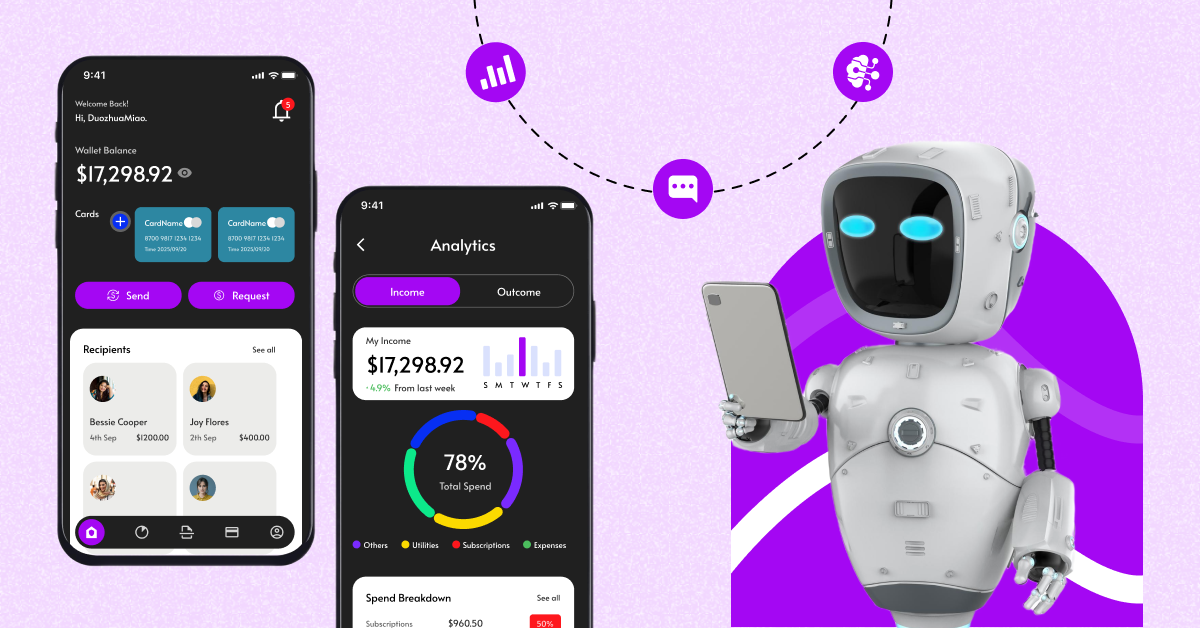Proof of Concept vs Prototype vs MVP: What’s the Difference?

Product teams know that when they take on a new project, three terms naturally follow: PoC, Prototype and MVP.
These terms are more than just industry jargon; each plays a critical role in the success of the product, both in terms of function and market performance.
A proof of concept is a small-scale project used to determine the technical viability of a new concept, a technology, or an approach.
A prototype, on the other hand, is a working model used to test features, validate requirements, and collect feedback on a proposed product idea.
The two differ from an MVP, which is a basic version of the final product. It has just the core feature(s) and is used to find out the marketability of the product.
The sections below touch on these topics in detail. Read on to find out what separates these three vital concepts from each other.
Table of Contents
Key Takeaways
- PoC, MVP and prototype are important concepts in the product development lifecycle.
- A PoC is used to test the technical feasibility of a product idea or function.
- A prototype is a functional replica to showcase the functionality and visual elements of a product.
- An MVP is a barebones version of the final product that is released to the market to gather user feedback.
- It helps to seek the assistance of an experienced product development company when dealing with these three approaches.
What is a Proof of Concept (PoC)?
A proof of concept is a minor project that demonstrates whether an idea or a particular method in product development is feasible and can be advantageous in the production environment.
A PoC is usually developed in the project discovery phase and is mainly used for internal purposes. It helps development teams finalize the tech stack, the tools they will be working on, and the resources required. A PoC can also be used to showcase the value of a product to stakeholders.
Developing a PoC comes with numerous advantages. Here are a few.
- Time- and cost-effective
- Opportunity to check the technical validity of the product before development
- Gathering feedback to be used in development
- Find solutions for technical challenges that may arise
How to Build a Proof of Concept?
To build a proof of concept, you must clearly define the product idea, set product scope, build a team, develop a PoC, prepare extensive documentation, and track performance metrics. Here is a brief explanation of the steps involved.
- Define Product Idea: You must have a clear idea of the objectives you plan to achieve. Lack of clarity often leads to avoidable delays.
- Set Product Scope: Plan a timeline, the deliverables, the resources required, the tech stack to be used, and the functions to be tested in the PoC.
- Build a Team: Building a PoC requires the efforts of members from different teams, from developers and engineers to designers and subject matter experts. It is important to ensure everyone involved is on the same page.
- Develop a PoC: The PoC is developed using a variety of tools and technologies.
- Prepare Documentation: Every step of the PoC development process is documented for future reference.
- Track Performance Metrics: The performance of the PoC is recorded and analyzed to check its adherence with product objectives.
What is a Prototype?
A prototype is a preliminary version of a product that is built to assess concepts and collect feedback before the product heads into full-scale development. It simulates how the app looks and feels, giving stakeholders an opportunity to interact with the product.
In addition to interaction, a prototype also helps with feedback collection, design concept validation, and usability testing. Prototypes are either paper-based (hand-drawn wireframes), digital (clickable versions), or miniatures.
There are three main approaches when it comes to prototypes. They are briefly discussed below.
- Rapid Prototyping: As the name suggests, these are built to test specific functions or ideas for quick results.
- Evolutionary Prototyping: In this approach, the prototype goes through numerous iterations and is refined based on user feedback until product development is completed.
- Incremental Prototyping: A single prototype is broken down into smaller pieces and perfected based on feedback. The perfected prototypes are then merged for a single, well-defined prototype.
How to Build a Prototype?
The steps to build a prototype include defining requirements, designing and creating the prototype, and refining it based on user feedback. Here is a brief explanation of the steps involved.
- Defining Requirements: Identify the product’s goals, stakeholder requirements, and the technical specifications the prototype must satisfy.
- Designing the Prototype: Collaborate with UI/UX designers and researchers to create the user interface of the prototype.
- Prototype Development: Build the prototype based on one of three approaches.
- Refining Based on Feedback: Gather user and stakeholder feedback and improve the prototype until it meets user and market expectations.
What is an MVP?
A minimum viable product (MVP) is the basic version of a product with just the core feature(s) that is released to gather feedback from users and test its marketability. It is an iterative process where the product goes through numerous transformations based on the feedback collected.
An MVP is a cost-efficient way to test a product idea, as it only has the core feature, without third-party integrations and visual elements. The time taken to develop an MVP is also comparatively less, giving founders a fast and effective way to learn more about the target market.
Here are a few reasons why you must consider building an MVP.
- To test the marketability of the product idea
- To understand how functional the core product idea is
- To refine the product into something that benefits the end user
- To reduce the time-to-market
- To ensure efficient usage of time and resources
The major difference between a PoC and an MVP is that the latter is a functional product while the former is a test implemented in the project discovery stage to validate the feasibility of an idea or a feature.
How to Build an MVP?
Building an MVP involves defining the problem, identifying MVP scope, developing the MVP, testing and launching it, and making improvements based on user feedback.
- Defining the Problem: Understand the problem the MVP plans to address by researching the target market. Analyze the competitors to identify their strengths and weaknesses.
- Identifying MVP Scope: Determine the feature(s) to be included in the MVP based on research data and user requirements.
- MVP Development: Code the core function(s) and user interface of the MVP.
- Testing: Test the developed MVP for bugs, functionality, and ease of use.
- Launching the MVP: The MVP is launched to a group of early adopters on select platforms.
- Feedback-Based Iterations: Review user feedback to identify common themes and make the necessary changes. The MVP is launched again, and the process is repeated.
PoC vs Prototype vs MVP: Major Differences
It’s important to understand why the PoC vs prototype vs MVP debate exists in the first place. Although they’re all part of the product development lifecycle, there are subtle differences that are often overlooked.
To clear these doubts, we have put together a table that shows the differences between PoC and MVP and prototype. It features six categories and data on how the three differ from each other.
| Category | PoC | Prototype | MVP |
|---|---|---|---|
| Purpose & Scope | Demonstrate feasibility and value of product. | Simulate user interface, interaction, and functionality. | Test market and refine product idea. |
| Development Stage | Project Discovery | Product Design | Pre-Launch |
| Functionality | Dependent on product idea | Has multiple features | Has only the core feature(s) |
| User Interaction | Minimal | High | High |
| Target Audience | Stakeholders, investors, product partners | Internal teams, stakeholders, end users | Early adopters, investors |
| Duration | Short-term | Mid-term | Long-term |
How to Choose the Best Approach for a Startup?
Making the right decision between the three can be complicated, especially for startups. Questions like “What is the difference between PoC and MVP?” or “Can I settle with just one of the three?” are quite common.
To clear things up, here are three tips to decide whether a certain approach is right for you.
- Clarity on Objective: An MVP is ideal to test a market idea, a PoC to validate the technical aspects, and a prototype to simulate the product functioning. Choose an approach based on your objectives.
- Mapping User Journey: A prototype or an MVP is recommended for situations where the user or user journey is involved.
- Market Testing: An MVP is the right choice for businesses looking to determine how marketable a product idea is.
Advanced PoC, MVP, and Prototype With CONTUS Tech
PoC, MVP, and prototype might seem different on paper, but there are critical aspects of product development that can’t be ignored.
The criticality is also the reason why businesses should opt for the services of a reputable product development company like CONTUS Tech.
CONTUS Tech has close to two decades of experience in the product development industry, developing scalable products that meet user, market, and business needs. Our expert PoC development services have helped businesses reduce development risks by up to 70%.
CONTUS Tech also helps businesses test a product idea through their MVP development services. Our six-step strategy ensures founders get measurable results on their product idea in the shortest time possible.
CONTUS Tech’s expertise extends to prototype development as well. Our experts are skilled at creating well-defined prototypes to demonstrate your product idea and get your project underway.
Conclusion
An MVP, a PoC, and a prototype are three concepts in product development that are interconnected. Each serves a unique purpose and happens in different stages. These approaches are beneficial in their own way.
This blog made some direct comparisons, like “proof of concept vs. MVP” and “PoC vs. prototype vs. MVP.”
In a nutshell, an MVP is useful when you need to check how your product will be received in the market. A PoC is utilized to check the technical feasibility of a product idea. A prototype is handy when you have to demonstrate how your product would look and behave to an audience, preferably the stakeholders.
The best part is that all these approaches are light on resource consumption and can be developed in a short period of time. So, rest assured that the investments made into these approaches will be useful down the line.
PoC. Prototype. MVP. One step closer to launch
FAQs on PoC, Prototype and MVP
PoC vs Prototype – Which One Comes First?
In product development, a proof of concept (PoC) usually comes before a prototype. Both have their own separate purpose. The PoC focuses on validating the technical feasibility of a product idea, while a prototype is a visual representation of the idea that allows testing user experience and functionality.
Proof of Concept vs MVP – How Do They Relate to Each Other?
A proof of concept (PoC) and an MVP are related concepts in product development with different purposes. An MVP is a simpler version of a product developed to validate market demand and collect user feedback. A PoC, on the other hand, is used to demonstrate the technical feasibility of a product idea. A PoC is the first step to validating a product idea, while an MVP is a basic version of the final product.
What should you choose: a PoC, a prototype, or an MVP?
The choice between a PoC, a prototype, and an MVP depends on the project’s stage and objectives, as each has its own purpose. A PoC focuses on validating the technical feasibility of a product idea, a prototype demonstrates design and user experience, and an MVP allows the testing of a product idea by releasing its basic version.
Is a prototype the same as an MVP?
A prototype and an MVP are initial versions of a product, but they serve different purposes. A prototype in product development is a non-functional, preliminary model that is used to test and refine a product’s concept and design. An MVP is an early version of the product with just the core feature(s). It is often used to analyze market demand and collect user feedback.
What are the key deliverables for the PoC, prototype, and MVP approach?
All three are parts of product development and serve unique purposes. A PoC proves the technical feasibility of the product through deliverables like a project plan, requirements documentation, and a technical feasibility report. A prototype’s goal is to demonstrate the visual and functional elements of the product, which is done through deliverables like interactive models and UI/UX design specifications. An MVP tests the marketability of the product, and its deliverables include a functional, shippable product, user feedback, and market validation data.
How do PoC, prototype, and MVP influence the development stages?
A PoC, a prototype, and an MVP help in resource allocation and risk management during the product development process. A PoC prioritizes the feasibility of a product idea, while a prototype showcases the product’s functionality and visual components. An MVP is a barebones version of the final product that is used to test the viability of the product idea.



